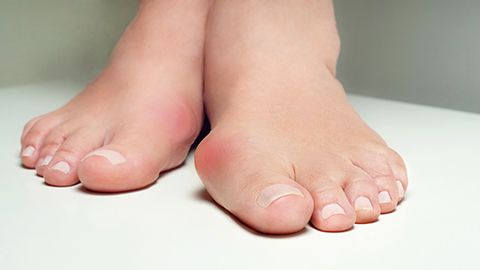
Bunions? Calcifications? Does it make a difference? A massage therapist isn’t sure what’s going on with her client’s foot and wants to know if it even matters. We will unpeel the layers of this situation to revisit bunions, Wolff’s law, osteoarthritis, and more. Come explore this gynglimoarthrodial joint with me—and no, I didn’t make up that word!


This podcast sponsored by Books of Discovery and Anatomy Trains.
00:00 Ruth Werner: Hi, and welcome to "I Have a Client Who," pathology conversations with Ruth Werner. The podcast where I will discuss your real life stories about clients with conditions that are perplexing or confusing. I'm Ruth Werner, author of A Massage Therapist's Guide to Pathology, and I have spent decades studying, writing about and teaching about where massage therapy intersects with diseases and conditions that might limit our client's health. We almost always have something good to offer, even with our most challenged clients, but we need to figure out a way to do that safely, effectively, and within our scope of practice. And sometimes as we have all learned, that is harder than it looks. In this episode, we're going to take on a question that sounds really simple, but it has some interesting layers that we can un-peel a bit. This comes from a massage therapist in New Jersey who asks this extremely succinct question. Client says her big toe is a calcification and not a bunion. Can you clarify? Different treatments. And that's it.
01:12 RW: So this gives us all kinds of room to speculate about what this client is dealing with, plus we get to talk a little bit about bunions, which I love to do. I often joke that I think at some point, I have developed every disease in my pathology book, including prostate cancer, which is a real trick, but when I talk about bunions, let me just share that I know where of I speak. I have very long feet and I grew up in very poorly fitting shoes, and I certainly went through my time of wearing shoes that I knew were bad for me, but oh, they looked so, so good. So, let's begin by defining what bunions are. This word comes from the French word oignon, which means bump. And usually, we refer to this in the context of a distorted joint between the first metatarsal and the proximal phalanx of the great toe. In other words, this is on the medial side of the foot at the base of the big toe, and what happens for a lot of people here is that because of some structural issues with their foot or maybe some genetic predispositions or the use of footwear that was not a great match for this foot or any combination of these things, the proximal phalanx of the great toe gets pushed laterally or outward.
02:37 RW: There is actually a form of bunion that happens on the lateral aspect of the foot at the joint between the fifth metatarsal and the proximal phalanx of the little toe, this is sometimes called a tailor's bunion, but most of the time we're talking about it on the medial side of the foot. Some people seem to be predisposed towards bunions. I had a student in massage school once who never wore anything but flat, super supportive shoes, and her bunions were huge. And she told me that they developed by the time she was three years old, so she may never have had a chance to interrupt that process. But anyone who starts with healthy feet can absolutely develop bunions if they try hard enough. And the best way to go about this is to use footwear that pinches the toes together, and that puts our weight directly through the ball of the foot with an emphasis on that first metatarsal on the great toe. And what I have just described to you, of course, is high heels, and because of that, it is not surprising that women get bunions way more often than men. Men can get bunions too, and we often see this in men who wear a masculine version of high-heeled shoes, which is to say cowboy boots.
03:52 RW: So, if you don't have bunion now, but you wonder what it would be like if you did, you could arrange for that to happen by investing in that fabulous pair of patent leather red peep toes stiletto pumps like I did, and then walk around for a while, but really, I don't recommend it. The technical term for bunions is hallux valgus. Although I've also seen it as hallux abducto valgus, and of course, what this means is that the hallux, the great toe is pointing outward. That's what valgus means, is laterally deviated. Now, the joint between the proximal phalanx and the head of the first metacarpal is relatively shallow, and some people classify this as a modified ball and socket joint or a cup and saucer kind of joint, but really its range of motion is just flexion and extension.
04:48 RW: I dove down into this rabbit hole a little bit, and I found one resource on injuries of the great toe that I will link to in the show notes, and that calls this joint a ginglymoarthrodial joint, which they define as a ball and socket hinge joint with a sliding component. Well, that was irresistible. So I looked up the etymology for gingly, and a ginglymus is a joint allowing motion in one plane only. And if you already knew that you win, because I certainly didn't. In any case, some people with extraordinarily movable feet may be able to do some other slight movements at that joint between the great toe and the first metatarsal, but it's not typical. One thing we see with the risk for bunions is that if the shape of the head of the first metatarsal is very, very round, then the joint is less stable and it's more vulnerable to being laterally deviated. So now we have a joint that is out of its best alignment, and it might be inflamed and painful in the same way that other types of inflamed joints, that's osteoarthritis, in the same way that other types of osteoarthritis hurt.
06:03 RW: It's deep and achy, but it's not sharp and acute, not yet. And we are so versatile, especially in the way we compensate for various movement limitations that this can develop without enough pain to make us stop whatever we're doing that's causing the great toe to point outward and causing arthritis. And when this situation has been present for a long time, then we know that bones will change their shape to adapt to the kinds of stresses we put on them. That's a very, very simplistic rephrasing of Wolff's Law, which basically gives us the concept that bone is living tissue. It's alive and it will change its form depending on what we ask it to do. So now we have distorted bones in this joint, and this is gonna cause the synovial membrane on the lateral side to be compressed and on the medial side, that synovial membrane is gonna get stretched out, it's also gonna require the external ligaments to adapt to this change in position and they don't like it that much, and it's going to create a point of friction where that corner of the foot hits whatever kind of footwear the person uses.
07:17 RW: In our bodies, we have a knack of accommodating for those friction points. One of the ways we do that is by growing bursa. Those are fluid-filled sacs that we find on all our sharp corners, we have them on elbows and knees, we have pre-existing bursa distributed all through the body, or we can actually grow new ones. And the bursa that are constantly irritated can become enlarged and painful. Bursa are really good at getting inflamed, and this pain is no longer deep and achy, this pain is now sharp and exquisite. So, if this situation keeps on developing over a long period of time, then we are likely to grow extra thick layers of skin on top of the whole protrusion. This is to say, now we have callus on top of the bursa, on top of the distorted joint, which is composed of bones that have become misshapen. So this client that has been described to us has some kind of bump on her foot, and the client says, it's not a bunion, it's a calcification, and the massage therapist wants to know is there a difference and is there a different kind of approach to treating these things?
08:29 RW: Well, without getting a look at some x-rays of this person's foot, it would of course be impossible to comment about the level of calcification that they might be experiencing. If they have the typical bump on the medial side of the foot, it's probably safe to say that they started with some level of joint distortion, that is to say a bunion, and the bones have adapted to that by maybe growing extra wide at the epiphyses, that's not an unusual response to constant friction and irritation. The more salient question is, what are the treatment options for these two things, bunions or calcifications of the foot, and would those options be different? If I were an orthopedic surgeon, it is possible that if this person wanted surgery to align her great toe, I might have some different expectations about what would have to happen in that process, if there was significant bony remodeling that would have to be fixed, or if it were just a simpler joint misalignment.
09:27 RW: There are bunion surgeries that really try to preserve the function at that metatarsophalangeal joint, but one kind of bunion surgery just fuses those two bones, which puts the bones in correct relationship, but then of course, eradicates any future range of motion that might have allowed those bones to move against each other. My educated guess is that the more bony distortion there is, the more limiting that foot surgery would have to be. Other medical treatments for bunions include things like injected cortisone to deal with local inflammation, using non-steroidal anti-inflammatories for pain, people will be expected to change their footwear, sometimes they even have to cut holes in their shoes to allow for these painful bony distortions. In the realm of body work to address bunions, we have a surprising number of options, but one option we cannot offer is a promise that we will make bunions go away. Let's remember that, especially for someone who's had bunions for a long time, this is a situation where there's been bony deformation and realignment within the joint, and we just don't have access inside those joint capsules.
10:40 RW: Now, in preparing for this podcast, I did look at a few websites that, where body workers claimed to be able to fix bunions through their hands-on therapies, and I just want to express my respectful skepticism. I have never seen this work. I cannot wrap my head around a possible mechanism, and I'm just not crazy about the idea of making a claim that our work will re-align these bones after there's been bony deformation. That said, what we can do is work with the musculature and other soft tissues of the foot. We can help people with range of motion exercises, we can provide super gentle traction, friction around the area, but I don't recommend friction directly on the bump, because that might make it hurt and make it flare up and swell and be painful. But there's a lot that massage therapy can do for general foot health, which is then going to have an impact on everything throughout the body.
11:38 RW: Now, I'm someone who's had a long history of various kinds of foot issues, and I'm especially aware that my feet are how I communicate with gravity, and when something is off-kilter in my foot, I know it will have an impact on my knee and my hip and my low back, and sooner or later I am gritting my teeth because I did something funky to my foot. So, the conclusion I would offer this massage therapist who has this question about her client with a bump on her foot that looks like a bunion, but the client says no, it's a calcification, well, as far as we're concerned, it probably doesn't make a great deal of difference. If the client is considering foot surgery to repair it, it's probably gonna make a big difference to her surgeon, and if the client goes through surgery to correct this, there will be very good work for the massage therapist to do, because any time the word foot and knife go in the same sentence, you know you're looking at a long and often challenging recovery.
12:40 RW: But for the person who's simply coming in and they have a big painful bump on their foot and but it's not actively inflamed, then we can work all around it. We can offer some gentle range of motion and traction, we can give specific attention to the musculature and the ligaments in the foot and in the lower leg, but I think it really would be misguided to suggest that it's within our capacity to fix this problem. Now, I know lots of us have clients or have had clients with bunions, and it's always great to revisit some of these concepts, because of course, this issue with bunions brings up things about osteoarthritis and bony distortions, and Wolff's Law and bursitis and the way the skin grows when we cover these friction points, it's amazing, and they... The bunions offer us a chance to peek into a lot of what we learned about how we understand human bodies function. I love to brush that stuff off every now and then, so I wanna offer my special thanks to this client and to this massage therapist in New Jersey who have given us that opportunity.
13:44 RW: Hey everybody, thanks for listening to "I Have a Client Who," pathology conversations with Ruth Werner. Remember, you can send me your "I Have a Client Who" stories to ihaveaclientwho@abmp.com. That's ihaveaclientwho, all one word, all lowercase @abmp.com. I can't wait to see what you send me and I'll see you next time.